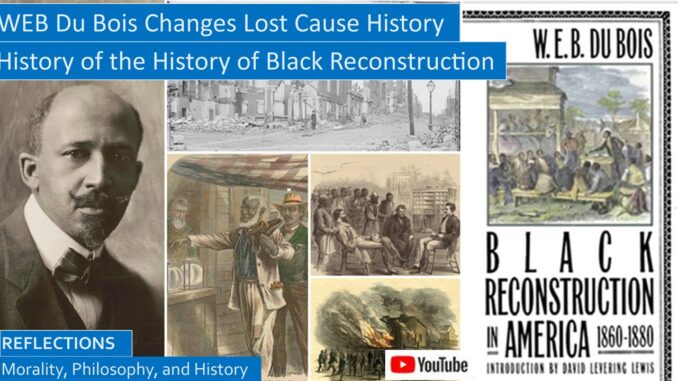
We have already published a video and blog on the ground-breaking book by WEB Du Bois, Black Reconstruction in America, 1860-1880, in which we see how the contrariness of WEB Du Bois can advance the cause of black history. The established dogma was that the Reconstruction Era following the Civil War was a dark period in American history, where black rule bred corruption and unwanted federal interference in the governments of the Deep South. WEB Du Bois counters by claiming that the Jim Crow Redemptionist Era following Reconstruction was the dark era when blacks lost the right to vote and any semblance of due process and fair play, that many blacks were, in effect, re-enslaved in a more brutal segregationist society, and that the Reconstruction was a time of greater democracy where the civil rights and liberties of all races and classes were respected.
This YouTube video: https://youtu.be/CK4V3e-TPFU
Script for this video, with Amazon book links: https://www.slideshare.net/BruceStrom1/history-of-history-of-web-dubois-black-reconstruction-challenging-lost-cause-myth-dunning-school
During his tenure as professor of sociology at Atlanta University, WEB Du Bois sought to advance the cause of the Negro by scholarship as well as by activism, and his efforts had real effect, as he was published in the national press, including the Atlantic Magazine, founded during the abolitionist era, and Foreign Affairs, as we discussed in our video on the later part of his life. During the transition period between his first stint at Atlanta University and his co-founding of the NAACP civil rights activist organization, Du Bois obtained funding to attend and deliver a paper on Reconstruction at the American Historical Association, he considered it as both “a personal honor and a racial challenge.”
David Levering Lewis, WEB Du Bois’ biographer, says it best, “To suggest that there had been benefits to Reconstruction was equivalent to describing benefits in the aftermath of the plague. Only a few feet away from the lectern on which Du Bois arranged his speech sat Columbia University’s William Archibald Dunning, high priest of the regnant dogma in Reconstruction scholarship, founder of the Dunning School, whose successive generations of historians deplored the decade of federal intervention in the South as a ‘tragic era’ of Negro misrule.
Du Bois told his fellow historians, “Granted then that the Negroes were to some extent venal but to a much larger extent ignorant and deceived,” the real issue was whether they showed “any disposition to learn better things?” Du Bois, in contrast, contended that it was the federal government who failed to create and sustain the Freedmen’s Bureau, which in its short existence worked to better black education, public hospitals, fair labor contracts, judicial due process, and guaranteeing black suffrage, confronting white supremacy and sometimes the KKK night riders.
In his presentation, WEB Du Bois summarized three accomplishments of Negro rule in the Deep South during Reconstruction:
- Democratic government.
- Free public schools.
- New social legislation.
Mr Dunning had mild praise for this paper by WEB Du Bois that sought to turn Reconstruction scholarship on its head, and the paper was published in the American Historical Review in July 1910, but was virtually ignored by mainstream scholars, overwhelmingly white, until the Civil Rights era of the Sixties.
One minor accomplishment that Booker T Washington had also promoted is a change in style in scholarly publications, that the word “Negro” should be capitalized. This small change emphasized that Negroes should be treated with dignity like all other people.[1]
Ironically, the current holder of the Dunning history chair at Columbia University is Eric Foner, who has advanced the thesis of Black Reconstruction by careful historical research in the newspaper articles during this time period. He has published many books on Reconstruction history, including the Second Founding, a history of the Reconstruction Amendments abolishing slavery, granting citizenship to all males born in the United States, guaranteeing due process to all citizens, and guaranteeing that all citizens have the right to vote.
In our discussion on our video/blog on WEB Du Bois’ roughly two decade stint as co-founder of the NAACP and editor of the NAACP Crisis magazine, which successfully helped the NAACP gain recognition as the leading civil right activist organization, we discussed that one of many reasons for his resignation from the NAACP, though he continued to submit important articles to the Crisis magazine, and his reemployment as professor of sociology at Atlanta University, was that he wanted to embark on a major research project, the ground-breaking book based on the ideas of his paper so many decades prior, Black Reconstruction in America, 1860-1880. He was encouraged in this project by black leaders, including James Weldon Johnson.[2]
What cultural influences did his book Black Reconstruction seek to combat? One of the first public relations battle of the NAACP and WEB Du Bois as editor of the Crisis magazine was the popularity of JW Griffith’s movie, the Birth of a Nation, that glorified the Ku Klux Klan as Ivanhoe-like white knights seeking to protect the sanctity of white womanhood, rather than the brutal white supremacist night-rider thugs who terrorized, vandalized, and sometimes raped and murdered blacks who were trying to vote, stand up for their rights, and earn a decent living. This movie led to the second incarnation of the KKK, the original KKK had been driven out of existence by federal troops ordered into the South by General Grant under the Civil Rights legislation passed by Congress.
The Birth of a Nation was both an unapologetically racist movie, shocking many even in the prewar times in 1915, leading to many communities banning this film from their local theaters, and it was also a technologically groundbreaking film in the history of film making. This movie was the longest movies of the time by a long shot, running for a full three hours, using revolutionary filming techniques which you can read about in Roger Ebert’s review of this historical film.
https://www.rogerebert.com/reviews/great-movie-the-birth-of-a-nation-1915
WEB Du Bois wrote Black Reconstruction when he was becoming more interested in communism, but WEB Du Bois mostly uses communist code words, such as comparing the black proletariat to the white proletariat, while noting that in America there is little class cohesion along economic lines, as the white workers are just as hostile to Negroes as more well-to-do whites. Never does WEB Du Bois promote the Bolshevik idea that the lower classes should overthrow the established social order with armed violence, his is more of a gentler, kinder kumbaya kind of communism found only in utopian dreamlands.
SUMMARY OF WEB DU BOIS’ BOOK, BLACK RECONSTRUCTION
WEB Du Bois in Black Reconstruction reminds us that before the Civil War the market value of slaves was the most valuable asset class in the country. In today’s dollars, a slave was worth as much as an economy car is worth today. Slaves were treated like they were talking livestock, most slaves were denied the ability to marry, healthy young Negro women who were considered to be potential “breeders” fetched high prices on the slave auction blocks.
The chapter subheads are a good summary of the book.
Chapter 1: Black Worker
“How black men coming” over three centuries became both a “challenge to its democracy and always an important part of its economic history and social development.”
Chapter 2: White Worker
“How America became the laborer’s Promised Land and flocking here from all the world the white workers competed with black slaves” “and with growing exploitation.”
Chapter 3: The Planter
“How seven percent of the nation ruled five million white people and owned four million black people and sought to make agriculture equal to industry through the rule of property without yielding political power or education to labor.
Chapter 5: The Coming of the Lord
“How the Negro became free because the North could not win the Civil War if he remained in slavery. How arms in his hands, and the prospect of arms in a million more black hands, brought peace and emancipation to America.”
Chapter 6: Looking Backward
“How the planters, having lost the war for slavery, sought to being again where they left off in 1860, merely substituting for the individual ownership of slaves, a new state serfdom of black folk.”
WEB Du Bois reminds us how blacks were terrorized and wantonly murdered, their bodies left to rot on the roads, without any judicial recourse.
WEB Du Bois writes, “While all instruments of group control, police, courts, government appropriations, were in the hand of whites, no power was left in Negro hands. If a white man is assaulted by a white man or a Negro, the police are at hand. If a Negro is assaulted by a white man, the police are more apt to arrest the victim than the aggressor; if he is assaulted by another Negro, he is in most cases without redress or protection.”
We also recommend that you read our biographer Lewis’ brief summary of Black Reconstruction.[3]
Historians have been critical of WEB Du Bois for limiting his sources to relatively easily accessible sources such as Congressional Reports and convention proceedings, dissertations and monographs, with only the occasional newspaper article. These sources were sufficiently comprehensive to paint a coherent picture of the Civil War and Reconstruction eras. He would have risked his life traveling to rural courthouses, libraries, and newspaper offices in the Deep South to consult the original sources, not to mention the fact that he did not have the research budget to travel across the Deep South.
After several years of research, Black Reconstruction was published in April 1935. Although the book did not sell out its initial print run of several thousand copies, it did garner many approving reviews by publications outside of the Deep South, especially the New York Hearst daily newspapers. Many historians reconsidered their views of Reconstruction, even in the Deep South. There was some denigration, the New Yorker proclaimed that the author took the “odd view, in distinction to most previous writers, that the Negro is a human being.”[4]
Another issue that is directly related to white supremacy is the issue of lynching, whether lynching was justified to protect the sanctity of white womanhood, or whether it was simply a brutal murder. Publicizing the false narratives that justified lynchings was the lifework of another co-founder of the NAACP and brave journalist Ida B Wells. The NAACP magazine, the Crisis included a monthly tally of lynchings so it would be continually in the public eye. There were likely over ten thousand blacks who were lynched in the years after the civil war, lynchings somewhat stopped at about the time of the Civil Rights era of the Sixties.
DID THE DUNNING HISTORIANS REGARD BLACKS AS INHERENTLY INFERIOR?
Our biographer Lewis includes several quotes from leading Dunning School historians that suggest that they agreed with Chief Justice Taney in the infamous Dred Scott Decision, which we discussed in our Second Founding video/blog, not only was the black man inherently inferior; the black man “had no rights which the white man was bound to respect,” blacks were considered lesser human beings. Indeed, under slavery, slaves were regarded as if they were talking livestock. We also explored this white supremacist attitude in our survey of slave autobiographies of Frederick Douglass, the first generation of black leaders; Booker T Washington and Father Augustine Tolton, the second generation of black leaders, and WEB Du Bois Souls of Black Folk, who was born during Reconstruction and belonged to the third generation of black leaders.
https://youtu.be/7VkzhyNnuQk and https://youtu.be/yxDnJ6sBoJc and https://youtu.be/dZbzWJkAf5k and https://youtu.be/x212gx1lNIA
Dunnings’s professor John Burgess in Reconstruction and the Constitution stated that “a black skin means membership in a race of men which has never of itself succeeded in subjecting passion to reason.” In 1910 Albert Hart in the Southern South concluded that “the Negro race is inferior, and his past history in Africa and America leads to the belief he will always be inferior.” Perhaps his view is : once a slave, always a slave, and this slavishness is inheritable, ignoring the obvious intelligence shown by the black leaders we mentioned, the first three were illiterate and learned how to read and write with great effort.
Also, in 1910 the future President Woodrow Wilson published Division and Reunion, that “interpreted the purging of Negroes from office-holding and the voting rolls of the South as merely the belated result of the natural, ‘inevitable ascendancy of whites.’” Lewis has similar quotes from white historians, including the historian Frederick Jackson Turner, who saw the closing of the frontier in the 1890’s as a key transition in the history of the United States, a viewpoint that downplayed the effect of the struggles of Negroes on American history. Often white historians blamed the blacks for their subservient position, some claiming they should have been more enterprising under slavery! Lewis also quotes from black historians more sympathetic to the arguments of WEB Du Bois in Black Reconstruction.[5]
The Encyclopedia Britannica invited WEB Du Bois to submit an entry on the Negro in the United States for its 1929 edition, but his article was not included because WEB Du Bois insisted that these two sentences be included that the editor objected to: “White historians have ascribed the faults and failures of Reconstruction to Negro ignorance and corruption. But the Negro insists that it was Negro loyalty and the Negro alone that restored the South to the Union, established the new democracy, and instituted the public schools.”[6]
HOW DID THE DEPRESSION AFFECT VIEWS OF HISTORIANS?
History, like relationships, can be complicated. Some historians, such as Charles Beard in his 1944 New Basic History of the United States, who recently experienced the Great Depression tended to interpret history from an economic viewpoint. WEB Du Bois could not ignore economics, slavery itself was the foundation of the antebellum economies of the Deep South slave states. Charles Beard may have read Black Reconstruction, but since he did not include a bibliography, we cannot tell. Charles Beard has this curious passage, “Millions of Negroes, hitherto held in bondage, generally illiterate, little experienced in management if often skilled in the arts of industry, without property, were now ‘free.’ Most of them in the Confederate states had been loyal and helpful to their masters and mistresses during the war and had not deliberately sought their freedom.”
No doubt there were some kind masters, and we explored some of these relationships in our slave autobiographies, and the kinder slave owners may have imagined that their slave would be loyal, but nearly all slaves were grateful to be freed, if for no other reason than they were free to marry and legally have a family and not work under the overseer’s whip. Beard mentions the Emancipation Proclamation only in passing, as if it were not truly a turning point in the Civil War.
Maybe he did read Black Reconstruction, as Charles Beard adds, “There were exceptions, thousands of exceptions” of slaves eager to be freed. “At least 100,000 Negroes had served in the Union armies as soldiers and laborers. As the Union armies advanced in the South, other thousands of Negroes gave them aid and support in the hope of forwarding their own liberation.” Beard is understating the role Negroes played in the Union victory, if there were 100,000 Negro soldiers, there were hundreds of thousands aiding the Union cause.
Beard continues, “In the South as well as the North, hundreds of Negroes, intelligent and educated, furnished some leadership for their bewildered people.” Beard also notes how the black codes were passed restricting the rights of the freedmen, which he says that Northerners saw this as an “attempt to restore slavery under another name.”[7]
There were many narratives Charles Beard chose to ignore. Although he mentions Frederick Douglass in passing, he does not mention either Booker T Washington or WEB Du Bois, he does not mention the brutality of Reconstruction and the Jim Crow Redemption era that lasted until the Sixties. There is only one footnote reference for the Ku Klux Klan, there is no mention of the tens of thousands of lynchings in the Deep South, there is no mention of the total lack of due process for blacks, no mention of how blacks lost the right to vote. Beard declines to speculate how segregation actually hurt the Southern economy.
HOW DID THE NAZI RACE POLICIES AFFECT CIVIL RIGHTS ERA?
Historians often tell you more about themselves, the times in which they live, and the historical culture that absorbs into their pore than the histories of past civilizations they paint. It was no accident that both the Civil Rights movement, social justice, and the Second Vatican Council all peaked in the Sixties, a mere two decades following the Second World War. This shift in historical perception meant that WEB Du Bois’ ideas in his book Black Reconstruction became the predominant historical narrative, while the Dunning School became an historical curiosity.
The experiences of the horrors of fascism and totalitarianism, and millions of Jews murdered in the Holocaust, preceded by the persecutions of the Jews in the Nazi race laws, affected how historians viewed the Civil War, Reconstruction, and Jim Crow Redemption eras. There are explicit links between white supremacy and Nazism, the Nazi lawyers used the Jim Crow laws as precedent when drafting the Nazi Race Laws soon Hitler assumed power.
This political shift occurred in public attitudes about peonage, the enslaving of poor blacks under vagrancy statutes in the brutal convict labor system, which was really an American system of abusive convict labor camps with high mortality rates from harsh working conditions, inadequate food and medical care, and hazardous working conditions. This was a more brutal form slavery than before the Civil War.
We compared Martin Luther King’s Letter from a Birmingham Jail to Hannah Arendt’s work on the Banality of Evil, drawn from her observation of the Israeli trial of Adolph Eichmann, the bureaucratic Nazi who administered the Nazi death camp system. There are parallels, Martin Luther King explicitly compares the black experience of segregation and lack of due process to the Nazi persecution and murder of millions of Jews in the Holocaust, viewing the tens of thousands of lynchings of blacks over many decades as an American Holocaust.
We have also cut a video/blog on how the World War II experiences of the Catholic Church and all Christians and clergy under the fascist regimes of Europe affect the calling and decrees of the Second Vatican Council. These decrees explicitly reject anti-Semitism, preaches respect for other religious traditions, rejects totalitarianism, views Democracy as a long-term friend of the Church, and reaffirms the Catholic Church’s preferential option for the poor, supporting social justice.
YOUTUBE
ACHIEVEMENTS OF THE BOOK, BLACK RECONSTRUCTION
Our biographer Lewis notes that, “By far, Black Reconstruction’s greatest achievement was to weave a credible historical narrative in which black people, suddenly admitted to citizenship in an environment of feral hostility, displayed admirable volition and intelligence as well as the indolence and ignorance inherent in three centuries of bondage. It invested these former slaves” “with what a later generation of historians would gravely call AGENCY.”
WEB Du Bois reveals how the emancipated blacks sought to improve themselves, were hungry to learn how to read, how to become educated citizens, how black citizens, like all American citizens, deserved respect, human dignity, due process under the law, an equal chance to education, an equal chance to learn and practice a trade and earn a living wage, and the right to vote, which safeguards all other civil rights.[8]
WEB Du Bois describes his view of American history. “Of all that most Americans wanted; this freeing of slaves was the last. Everything black was hideous. Everything Negroes did was wrong. If they fought for freedom, they were beasts; if they did not fight, they were born slaves. If they cowered on plantations, they loved slavery; if they scowled, they were impudent.[9]
DISCUSSION OF SOURCES:
We used as our primary source the biography of WEB Du Bois and his introduction to Black Reconstruction by David Levering Lewis, consulting WEB Du Bois’ autobiography as well, plus we had picked up the American history book by Charles Beard published in 1944, plus the many books we consulted for many of the other videos we mentioned.
[1] David Levering Lewis, A Biography, WEB Du Bois (New York: Holt Paperback, 2009), pp. 250-252, and introduction by David Levering Lewis in book by WEB Du Bois, Black Reconstruction in America, 1860-1880 (New York: The Free Press, 1935, 1962, 1998), p. vii.
[2] David Levering Lewis, A Biography, WEB Du Bois, p. 581.
[3] David Levering Lewis, A Biography, WEB Du Bois, pp. 587-590.
[4] David Levering Lewis, A Biography, WEB Du Bois, pp. 581-582.
[5] David Levering Lewis, A Biography, WEB Du Bois, pp. 578-579.
[6] Introduction by David Levering Lewis in book by WEB Du Bois, Black Reconstruction in America, 1860-1880, p. ix.
[7] Charles Beard, A New Basic History of the United States (New York: Doubleday and Company, 1944, 1960), pp. 274-277.
[8] David Levering Lewis, A Biography, WEB Du Bois, p. 586.
[9] David Levering Lewis, A Biography, WEB Du Bois, p. 587.

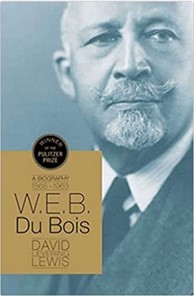
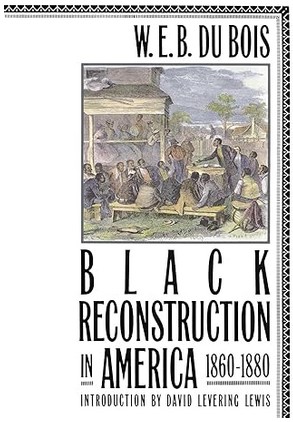
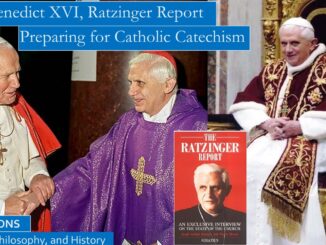

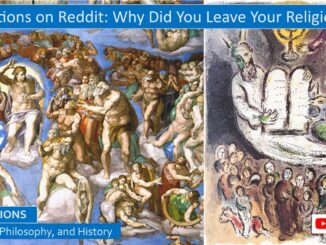
3 Trackbacks / Pingbacks